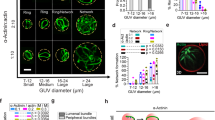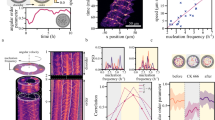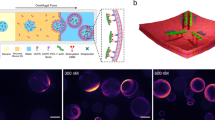Abstract
Polymerizing networks of actin filaments are capable of exerting significant mechanical forces, used by eukaryotic cells and their prokaryotic pathogens to change shape or to move. Here we show that small beads coated uniformly with a protein that catalyses actin polymerization are initially surrounded by symmetrical clouds of actin filaments. This symmetry is broken spontaneously, after which the beads undergo directional motion. We have developed a stochastic theory, in which each actin filament is modelled as an elastic brownian ratchet, that quantitatively accounts for the observed emergent symmetry-breaking behaviour. Symmetry-breaking can only occur for polymers that have a significant subunit off-rate, such as the biopolymers actin and tubulin.
This is a preview of subscription content, access via your institution
Access options
Subscribe to this journal
Receive 12 print issues and online access
$209.00 per year
only $17.42 per issue
Buy this article
- Purchase on Springer Link
- Instant access to full article PDF
Prices may be subject to local taxes which are calculated during checkout






Similar content being viewed by others
References
Drubin, D. G. & Nelson, W. J. Origins of cell polarity. Cell 84, 335–344 (1996).
Bornens, M. Cell polarity: intrinsic or externally imposed? New Biol. 3, 627–636 (1991).
Holmes, K. C., Popp, D., Gebhard, W. & Kabsch, W. Atomic model of the actin filament. Nature 347, 44– 49 (1990).
Sheterline, P., Clayton, J. & Sparrow, J. Actin. Protein Profile 2, 1–103 (1995).
Mogilner, A. & Oster, G. Cell motility driven by actin polymerization. Biophys J. 71, 3030–3045 (1996).
Miyata, H., Nishiyama, S., Akashi, K. & Kinosita, K. Jr Protrusive growth from giant liposomes driven by actin polymerization. Proc. Natl Acad. Sci. USA 96, 2048– 2053 (1999).
Lauffenburger, D. A. & Horwitz, A. F. Cell migration: a physically integrated molecular process. Cell 84, 359–369 (1996).
Mitchison, T. J. & Cramer, L. P. Actin-based cell motility and cell locomotion. Cell 84, 371–379 (1996).
Nabi, I. R. The polarization of the motile cell. J. Cell Sci. 112, 1803–1811 (1999).
Oliver, T., Lee, J. & Jacobson, K. Forces exerted by locomoting cells. Semin. Cell Biol 5, 139–147 (1994).
Elson, E. L., Felder, S. F., Jay, P. Y., Kolodney, M. S. & Pasternak, C. Forces in cell locomotion. Biochem. Soc. Symp. 65, 299–314 (1999).
Dramsi, S. & Cossart, P. Intracellular pathogens and the actin cytoskeleton. Annu. Rev. Cell Dev. Biol. 14, 137–166 (1998).
Tilney, L. G. & Portnoy, D. A. Actin filaments and the growth, movement, and spread of the intracellular bacterial parasite, Listeria monocytogenes. J. Cell Biol. 109, 1597–1608 (1989).
Theriot, J. A., Mitchison, T. J., Tilney, L. G. & Portnoy, D. A. The rate of actin-based motility of intracellular Listeria monocytogenes equals the rate of actin polymerization. Nature 357, 257–260 (1992).
Dabiri, G. A., Sanger, J. M., Portnoy, D. A. & Southwick, F. S. Listeria monocytogenes moves rapidly through the host-cell cytoplasm by inducing directional actin assembly. Proc. Natl Acad. Sci. USA 87, 6068–6072 (1990).
Sanger, J. M., Sanger, J. W. & Southwick, F. S. Host cell actin assembly is necessary and likely to provide the propulsive force for intracellular movement of Listeria monocytogenes. Infect. Immun. 60, 3609– 3619 (1992).
Kocks, C. et al. L. monocytogenes-induced actin assembly requires the actA gene product, a surface protein. Cell 68, 521–531 (1992).
Welch, M. D., Rosenblatt, J., Skoble, J., Portnoy, D. A. & Mitchison, T. J. Interaction of human Arp2/3 complex and the Listeria monocytogenes ActA protein in actin filament nucleation. Science 281, 105– 108 (1998).
Smith, G. A., Theriot, J. A. & Portnoy, D. A. The tandem repeat domain in the Listeria monocytogenes ActA protein controls the rate of actin-based motility, the percentage of moving bacteria, and the localization of vasodilator-stimulated phosphoprotein and profilin. J. Cell Biol. 135, 647– 660 (1996).
Kocks, C., Hellio, R., Gounon, P., Ohayon, H. & Cossart, P. Polarized distribution of Listeria monocytogenes surface protein ActA at the site of directional actin assembly. J. Cell Sci. 105, 699–710 (1993).
Theriot, J. A., Rosenblatt, J., Portnoy, D. A., Goldschmidt-Clermont, P. J. & Mitchison, T. J. Involvement of profilin in the actin-based motility of L. monocytogenes in cells and in cell-free extracts. Cell 76, 505– 517 (1994).
Cameron, L. A., Footer, M. J., van Oudenaarden, A. & Theriot, J. A. Motility of ActA protein-coated microspheres driven by actin polymerization. Proc. Natl Acad. Sci. USA 96, 4908– 4913 (1999).
Dold, F. G., Sanger, J. M. & Sanger, J. W. Intact alpha-actinin molecules are needed for both the assembly of actin into the tails and the locomotion of Listeria monocytogenes inside infected cells. Cell Motil. Cytoskeleton 28, 97–107 (1994).
Pollard, T. D. Rate constants for the reactions of ATP- and ADP-actin with the ends of actin filaments. J. Cell Biol. 103, 2747– 2754 (1986).
Hill, T. L. & Kirschner, M. W. Bioenergetics and kinetics of microtubule and actin filament assembly- disassembly. Int. Rev. Cytol. 78, 1–125 (1982).
Yarar, D., To, W., Abo, A. & Welch, M. D. The Wiskott-Aldrich syndrome protein directs actin-based motility by stimulating actin nucleation with the Arp2/3 complex. Curr. Biol. 9, 555–558 (1999).
Ma, L., Cantley, L. C., Janmey, P. A. & Kirschner, M. W. Corequirement of specific phosphoinositides and small GTP-binding protein Cdc42 in inducing actin assembly in Xenopus egg extracts. J. Cell Biol. 140, 1125–1136 (1998).
Coates, T. D., Watts, R. G., Hartman, R. & Howard, T. H. Relationship of F-actin distribution to development of polar shape in human polymorphonuclear neutrophils. J. Cell Biol. 117, 765–774 (1992).
Euteneuer, U. & Schliwa, M. Persistent, directional motility of cells and cytoplasmic fragments in the absence of microtubules. Nature 310, 58–61 (1984).
Verkhovsky, A. B., Svitkina, T. M. & Borisy, G. G. Self-polarization and directional motility of cytoplasm. Curr. Biol. 9, 11–20 (1999).
Gerhart, J. et al. Cortical rotation of the Xenopus egg: consequences for the anteroposterior pattern of embryonic dorsal development. Development 107, 37–51 (1989).
Theriot, J. A. & Fung, D. C. Listeria monocytogenes-based assays for actin assembly factors. Methods Enzymol. 298, 114–122 (1998).
Doi, M. & Edwards, S. The Theory of Polymer Dynamics (Oxford Univ. Press, New York, 1986).
Yanagida, T., Nakase, M., Nishiyama, K. & Oosawa, F. Direct observation of motion of single F-actin filaments in the presence of myosin. Nature 307, 58– 60 (1984).
Ott, A., Magnasco, M., Simon, A. & Libchaber, A. Measurement of the persistence length of polymerized actin using fluorescence microscopy. Phys. Rev. E 48, R1642– R1645 (1993).
Riveline, D., Wiggins, C. H., Goldstein, R. E. & Ott, A. Elastohydrodynamic study of acitn filaments using fluorescence microscopy. Phys. Rev. E 56, R1330– R1333 (1997).
Marchand, J. B. et al. Actin-based movement of Listeria monocytogenes: actin assembly results from the local maintenance of uncapped filament barbed ends at the bacterium surface. J. Cell Biol. 130, 331–343 (1995).
Laine, R. O. et al. Gelsolin, a protein that caps the barbed ends and severs actin filaments, enhances the actin-based motility of Listeria monocytogenes in host cells. Infect. Immun. 66, 3775–3782 (1998).
Acknowledgements
We thank L. Cameron for providing purified ActA–His protein for the experiment shown in Fig. 1, and K. Lustig, J. Robbins, K. Jung, L. Cameron, S. McCallum and P. Giardini for comments on the manuscript. This work was supported by grants from the NIH (AI36929) and the David and Lucile Packard Foundation to J.A.T., and from the Dutch Organization for Scientific Resarch (NWO) to A.v.O.
Correspondence and requests for materials should be addressed to J.A.T.
Author information
Authors and Affiliations
Corresponding author
Rights and permissions
About this article
Cite this article
van Oudenaarden, A., Theriot, J. Cooperative symmetry-breaking by actin polymerization in a model for cell motility. Nat Cell Biol 1, 493–499 (1999). https://doi.org/10.1038/70281
Received:
Revised:
Accepted:
Published:
Issue Date:
DOI: https://doi.org/10.1038/70281
This article is cited by
-
Bimodal sensing of guidance cues in mechanically distinct microenvironments
Nature Communications (2018)
-
Perinuclear Arp2/3-driven actin polymerization enables nuclear deformation to facilitate cell migration through complex environments
Nature Communications (2016)
-
Fabrication of three-dimensional electrical connections by means of directed actin self-organization
Nature Materials (2013)
-
Mathematics of cell motility: have we got its number?
Journal of Mathematical Biology (2009)
-
Actin-driven chromosomal motility leads to symmetry breaking in mammalian meiotic oocytes
Nature Cell Biology (2008)



